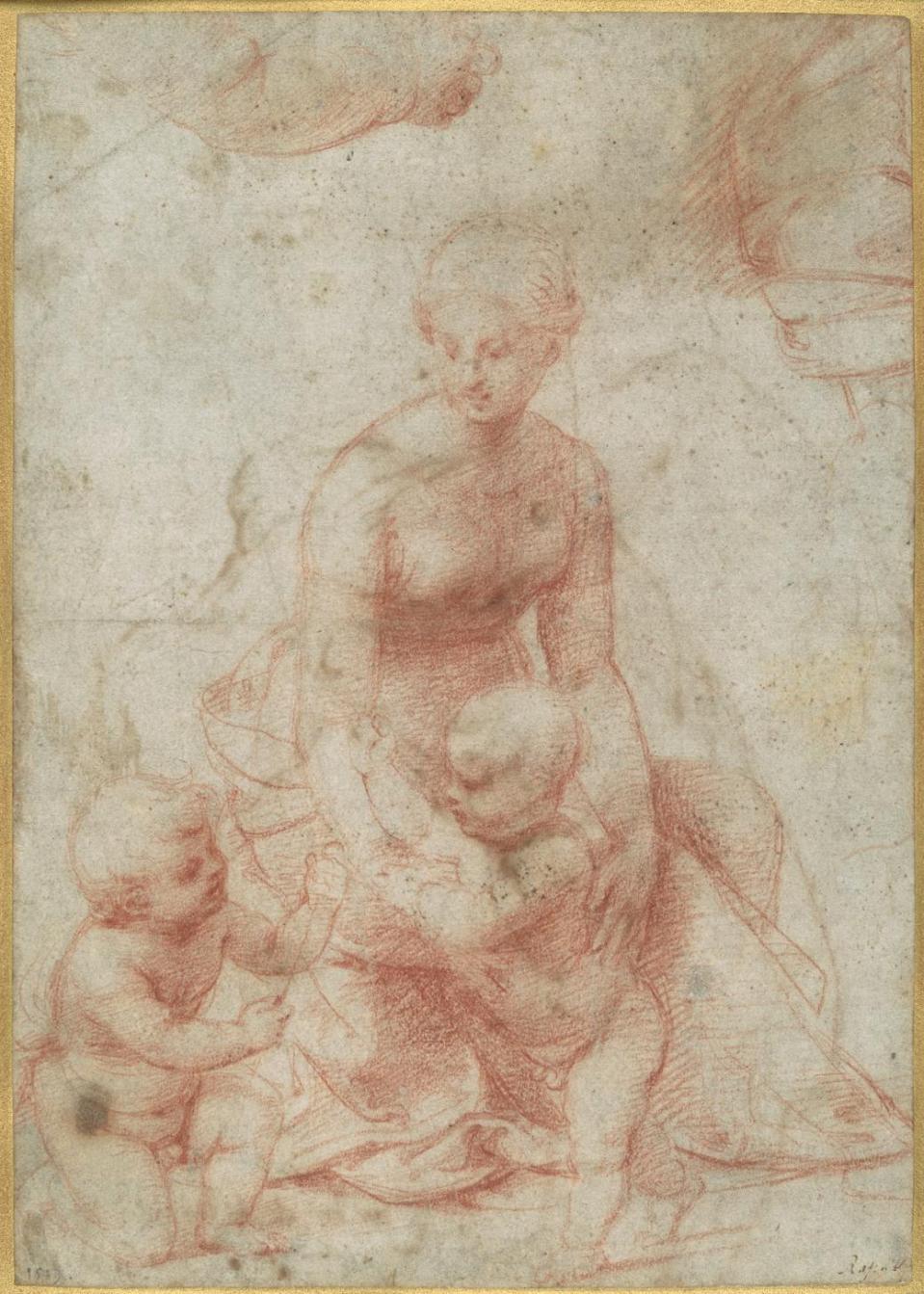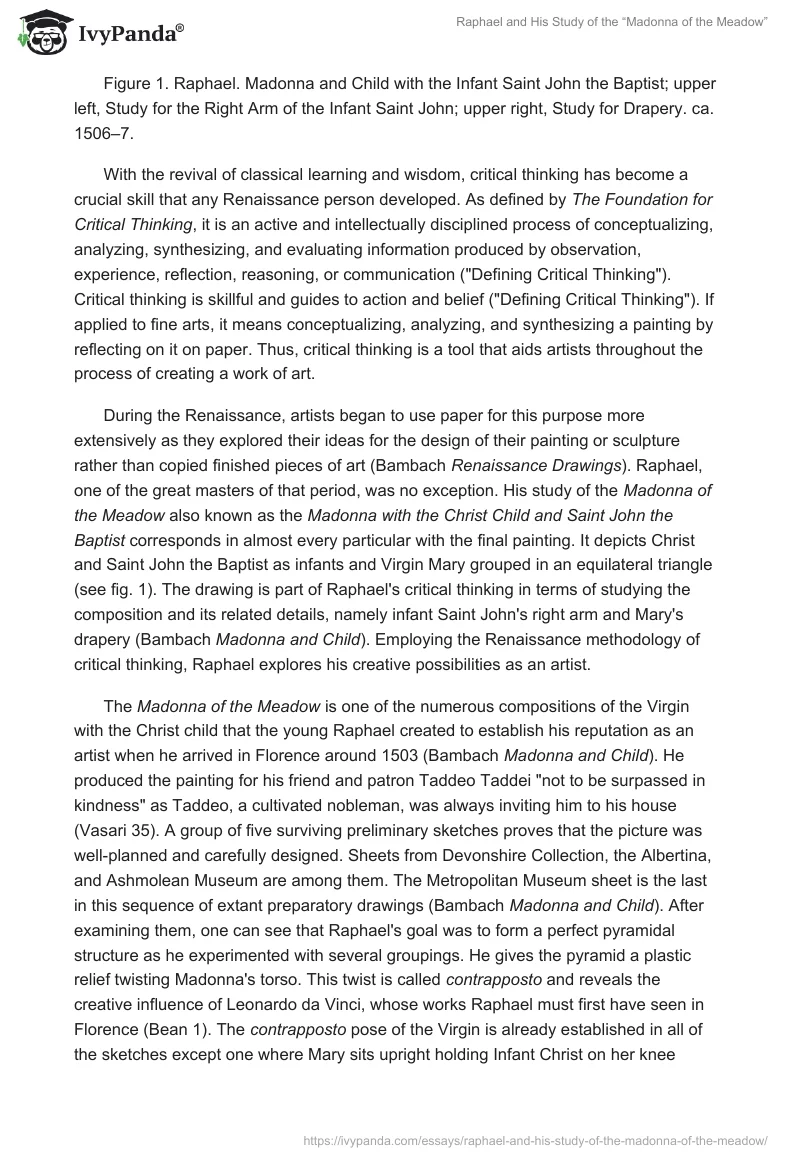
With the revival of classical learning and wisdom, critical thinking has become a crucial skill that any Renaissance person developed. As defined by The Foundation for Critical Thinking, it is an active and intellectually disciplined process of conceptualizing, analyzing, synthesizing, and evaluating information produced by observation, experience, reflection, reasoning, or communication (“Defining Critical Thinking”). Critical thinking is skillful and guides to action and belief (“Defining Critical Thinking”). If applied to fine arts, it means conceptualizing, analyzing, and synthesizing a painting by reflecting on it on paper. Thus, critical thinking is a tool that aids artists throughout the process of creating a work of art.
During the Renaissance, artists began to use paper for this purpose more extensively as they explored their ideas for the design of their painting or sculpture rather than copied finished pieces of art (Bambach Renaissance Drawings). Raphael, one of the great masters of that period, was no exception. His study of the Madonna of the Meadow also known as the Madonna with the Christ Child and Saint John the Baptist corresponds in almost every particular with the final painting. It depicts Christ and Saint John the Baptist as infants and Virgin Mary grouped in an equilateral triangle (see fig. 1). The drawing is part of Raphael’s critical thinking in terms of studying the composition and its related details, namely infant Saint John’s right arm and Mary’s drapery (Bambach Madonna and Child). Employing the Renaissance methodology of critical thinking, Raphael explores his creative possibilities as an artist.
The Madonna of the Meadow is one of the numerous compositions of the Virgin with the Christ child that the young Raphael created to establish his reputation as an artist when he arrived in Florence around 1503 (Bambach Madonna and Child). He produced the painting for his friend and patron Taddeo Taddei “not to be surpassed in kindness” as Taddeo, a cultivated nobleman, was always inviting him to his house (Vasari 35). A group of five surviving preliminary sketches proves that the picture was well-planned and carefully designed. Sheets from Devonshire Collection, the Albertina, and Ashmolean Museum are among them. The Metropolitan Museum sheet is the last in this sequence of extant preparatory drawings (Bambach Madonna and Child). After examining them, one can see that Raphael’s goal was to form a perfect pyramidal structure as he experimented with several groupings. He gives the pyramid a plastic relief twisting Madonna’s torso. This twist is called contrapposto and reveals the creative influence of Leonardo da Vinci, whose works Raphael must first have seen in Florence (Bean 1). The contrapposto pose of the Virgin is already established in all of the sketches except one where Mary sits upright holding Infant Christ on her knee (Bean 2). The drawing is the final stage of Raphael’s planning for the Madonna of the Meadow. It differs from the final version in only one significant detail: Virgin’s left arm is covered with drapery in the picture while it is free in the drawing (see fig. 1).
Preliminary sketches were a normal part of Raphael’s creative process. Throughout his career, he produced a large number of sketches before drawing studies. After that, he started working on the major lines of the painting he had in mind, transferring sections of each preparatory drawing toward the production of the final copy (“Raphael Drawings”). In addition, Raphael often relied on cartoons — full-sized studies or models — for transferring the picture to the painting support. In his earlier works, Raphael used silverpoint and ink; he is then observed to gradually start using black chalk when making more developed studies (“Raphael Drawings”). The study of the Madonna of the Meadow is one of the artist’s earliest drawings in red chalk. In Florence, Raphael discovered the work of Leonardo and Michelangelo, and probably they introduced the young newcomer to the medium of red chalk (Bambach Madonna and Child). Raphael’s other preparatory drawings include studies of nude male figures and infants, the study of The Descent from the Cross, numerous preliminary drawings drafting The School of Athens, the drawing of A Young Man Carrying an Old Man on His Back, the study of Saint Catherine of Alexandria, etc. They all played a crucial role during the artist’s both creative and critical thinking process being an indispensable tool for planning and designing.
In his study of the Madonna of the Meadow, Raphael employed a beautiful shade of soft red chalk and broadly indicated the structure of his composition (Bean 4). Hands are indicated very briefly, which tells us that he was concerned not with the delineation of detail but with the indications of the subtle contrasts of light and shade that modeled his forms (Bean 4). At the top of the sheet, Raphael added two studies: Saint John’s right arm and the folds of the Virgin’s mantle (see fig. 1). The two sub-studies are more detailed while the overall outline concentrates on light and shade. This fact as well as the outlining nature of the study shows how the artist’s thoughts in form of images appear during the process of planning the picture as a whole.
The group is animated by the arrested movement of Jesus-child who, reaching to touch the cross symbolic of his coming Passion, is held back by the tender solicitude of the Virgin (Bean 2). Even the directions of the glance of each figure — the Virgin looks down at the Baptist while the two infants look at each other — add to the artistic and emotional coherence of the group (Bean 2). As indicated by Bean, “the composition is completely satisfying and has a classical serenity permeated with Christian sentiment that has guaranteed its place as one of the master’s most celebrated pictures” (2). The final version’s success is preceded by numerous preparatory sketches that let Raphael think critically, plan carefully, explore his creative capacity, and hone his skills as an artist to an extent that makes him the greatest master.
Critical thinking through preparatory drawings works for Raphael in two ways. It can be an effective tool that helps create a masterpiece by designing and working on composition, details, shades, shadow, light, form, etc., or it can be the artist’s aim by itself. The former means that Raphael’s drawings are preliminary thoughts and drafts for a picture that provide an insight into his creative process. The latter means that any of the artist’s paintings are a representation of his critical thinking, philosophy, and understanding of the world. Critical thinking furthers Raphael’s studies being a mode of thought and a tool for exploring and experimenting with painting. It is an essential methodology for every artist who wants to excel in their craftsmanship.
Works Cited
Bambach, Carmen. “Madonna and Child with the Infant Saint John the Baptist; Upper Left, Study for the Right Arm of the Infant Saint John; Upper Right, Study for Drapery (Recto); Study of a Nude Male Figure (Verso).” The Metropolitan Museum of Art, 2006, Web.
“Renaissance Drawings: Material and Function.” In Heilbrunn Timeline of Art History. The Metropolitan Museum of Art, 2000-2021. Web.
Bean, Jacob. “A Rediscovered Drawing by Raphael.” The Metropolitan Museum of Art Bulletin, vol. 23, no. 1, 1964. Crossref, pp. 1-10.
“Defining Critical Thinking.” The Foundation for Critical Thinking, 2019, Web.
“Raphael Drawings.” Raphael Sanzio, 2017, Web.
Vasari, Giorgio, and Jill Burke. The Life of Raphael (Lives of the Artists). 1st ed., J. Paul Getty Museum, 2018.


